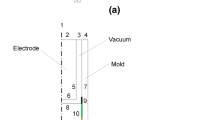Abstract
A mathematical model was established to simulate the weld pool development and dynamic process in stationary laser–metal inert gas (MIG) hybrid welding. Surface tension and buoyancy were considered to calculate liquid metal flow pattern; moreover, typical phenomena of MIG welding such as filler droplets impinging weld pool, electromagnetic force in the weld pool, and typical phenomena of laser beam welding such as recoil pressure, inverse Bremsstrahlung absorption, and Fresnel absorption were all considered in the model. The laser beam and arc couple effect was introduced into this model by the plasma width during hybrid welding. Transient weld pool shape and complicated liquid metal velocity distribution from two kinds of weld pool to a unified weld pool were calculated. Furthermore, the simulated weld bead geometries were in good agreement with experimental measurement.
Similar content being viewed by others
References
Jasnau U, Hoffmann J, Seyffarth P (2002) Nd: YAG–laser–gas metal arc–hybrid welding: a chance for the use of the advantages of laser technology and flexible automation in shipbuilding and steel construction. RWIA ‘02—2002 International Conference on Robotic Welding, Intelligence and Automation, Shanghai, China, 14–24
Wouters M (2005) Hybrid laser–MIG welding: an investigation of geometrical considerations. PhD thesis, Luleå University of Technology
Gvosdetzky VS, Krivtsun IV, Chzhenko MI, Yarinich LM (1995) Laser-arc discharge: theories and applications. Harwood, Newark
Cho MH (2006) Numerical simulation of arc welding process and its application. PhD thesis, The Ohio State University
Li ZN, Du D, Chang BH et al (2007) Flow patterns in the weld pool during laser-plasma hybrid welding. J Tsinghua Univ (Sci & Tech) 47(8):1263–1266
Zhou J, Zhang WH, Tsai HL et al (2003) Modeling the transport phenomena during hybrid laser–MIG welding process. IMECE ’03, Washington, D.C.
Zhou J, Tsai HL, Wang PC et al (2003) Modeling of hybrid laser–MIG keyhole welding process. ICALEO’03, Jacksonville, FL, Sec. A, 135–141
Zhou J, Tsai HL (2006) Computer simulation of laser welding and hybrid laser–MIG welding. Proceedings of International Symposium on Computer-aided Welding Engineering, Jinan, China, 97–106
Farson D (2006) Simulation-based and experimental development of hybrid laser welding processes. Proceedings of International Symposium on Computer-aided Welding Engineering, Jinan, China, 15–18
Brent AD, Voller VR, Reid KJ (1988) Enthalpy–porosity technique for modelling convection–diffusion phase change: application to the melting of a pure metal. Numer Heat Transf A 13:297–318
Ye XH, Chen Xi (2002) Three-dimensional modeling of heat transfer and fluid flow in laser full-penetration welding. J Phys D Appl Phys 35:1024–1056. doi:10.1088/0022-3727/35/10/313
Amberg L, Backerud L, Chai G (1996) Solidification characteristics of aluminum alloys, vol. 3: dendrite coherency. American Foundry Society, Des Plaines
Zhao YZ (2004) Simulation of fluid dynamics behavior and solidified structure in welding pool. PhD thesis, Beijing University of Technology
Wu CS (2007) Welding heat process and weld pool shape. China Machine Press, Beijing
Semak V, Matsunawa A (1997) The role of recoil pressure in energy balance during laser materials processing. J Phys D Appl Phys 30:2541–2552. doi:10.1088/0022-3727/30/18/008
Semak VV, Damkroger B, Kempka S (1999) Temporal evolution of the temperature field in the beam interaction zone during laser material processing. J Phys D Appl Phys 32:1819–1825. doi:10.1088/0022-3727/32/15/309
Zhou J (2003) Modeling of Transport phenomena during laser welding process. PhD thesis, University of Missouri-Rolla
Xian AP (2006) The physical properties of liquid metal. Science Press, Beijing
Kaplan A (1994) A model of deep penetration laser welding based on calculation of the keyhole profile. J Phys D Appl Phys 27:1805–1814. doi:10.1088/0022-3727/27/9/002
Zhao HL (2001) Quality issues in laser welding of automotive aluminum and magnesium alloys. PhD thesis, The Pennsylvania State University
Cao Z, Yang Z, Chen XL (2004) Three-dimensional simulation of transient GMA weld pool with free surface. Weld J 83(6):169s–176s
Wang Y, Tsai HL (2001) Impingement of filler droplets and weld pool dynamics during gas metal arc welding process. Int J Heat Mass Transfer 44:2067–2080. doi:10.1016/S0017-9310(00)00252-0
Zhou J, Tsai HL (2008) Modeling of transport phenomena in hybrid laser–MIG keyhole welding. Int J Heat Mass Transfer 51(17–18):4353–4366
Yang J, Wang FD 3D finite element temperature field modelling for direct laser fabrication. Int J Adv Manuf Technol. doi:10.1007/s00170-008-1785-x
Author information
Authors and Affiliations
Corresponding author
Rights and permissions
About this article
Cite this article
Gao, Z., Wu, Y. & Huang, J. Analysis of weld pool dynamic during stationary laser–MIG hybrid welding. Int J Adv Manuf Technol 44, 870–879 (2009). https://doi.org/10.1007/s00170-008-1896-4
Received:
Accepted:
Published:
Issue Date:
DOI: https://doi.org/10.1007/s00170-008-1896-4




